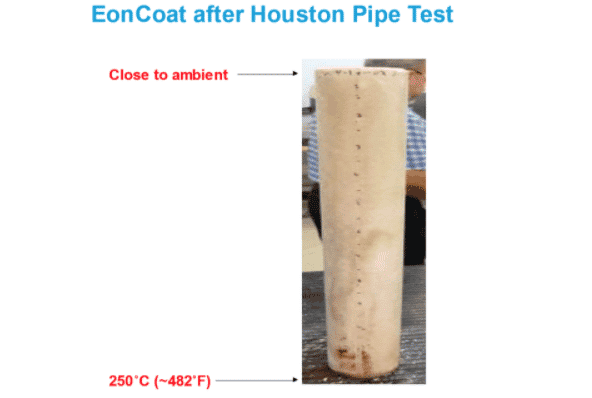Working with our scientists is the most fun thing I get to do. Nearly every day someone comes to me with a big grin because they know they’ve uncovered something significant, something that can help us continue to move into uncharted territory in the coating world. I guess that is how it is with new technologies – the advances continue rolling in faster and faster because so much is still unknown.
But there are heartbreaks too. This is about one of them.
Focusing on a High Temp Formulation
While some of our scientists were working on corrosion protection, others were collaborating in an effort to create the best high temp formulation of EonCoat. A lot of effort went into refining the matrix to make sure the appearance of the ceramic stayed the same in the high temp formulation as it does in the standard form of EonCoat up to temperatures in the thousands of degrees. Once the high-temperature performance was solved, many man-hours went into stabilizing the product for shelf life. The coating looked great and we were extremely proud.
Taking a Step Back
What none of us considered was what effect temperature would have on corrosion protection. After all, the coating looked great. But what we finally came to understand is that the ceramic layer is simply abrasion-resistant protection for the real corrosion layer which lies next to, and is really part of, the steel. EonCoat Lead Scientist Sameer Patel Testing EonCoat HT To our dismay we learned that the corrosion protection of the high temp coating after it had been heated, was only just as good as other corrosion coatings on the market. Ultimately we understood that the real corrosion layer is hydrated and once you heat the substrate above 212°F – the hydrate is gone.
Accepting Failure to Move Forward
We have many failures, but this one truly hurt. I had envisioned coating steam lines in power plants across the globe and no longer having CUI (corrosion under insulation) as an issue.
To be fair, the coating could still be used this way because it does offer some protection and the ceramic is still in good shape at high temps. Where the issue lies in that the corrosion protection of the High Temp variation is nowhere near what we’ve come to expect from EonCoat. We want high-temperature protection that is revolutionary.
So our efforts at high temp corrosion protection, and EonCoat HT, go into the loss column. I cannot tell you how difficult it was to write this.
“I have not failed. I’ve just found 10000 ways that won’t work” – Thomas Edison
UPDATE 6/2021:
10 years later – Lessons about Persistence. And Vision. And People.


Ready to Learn More About EonCoat?


